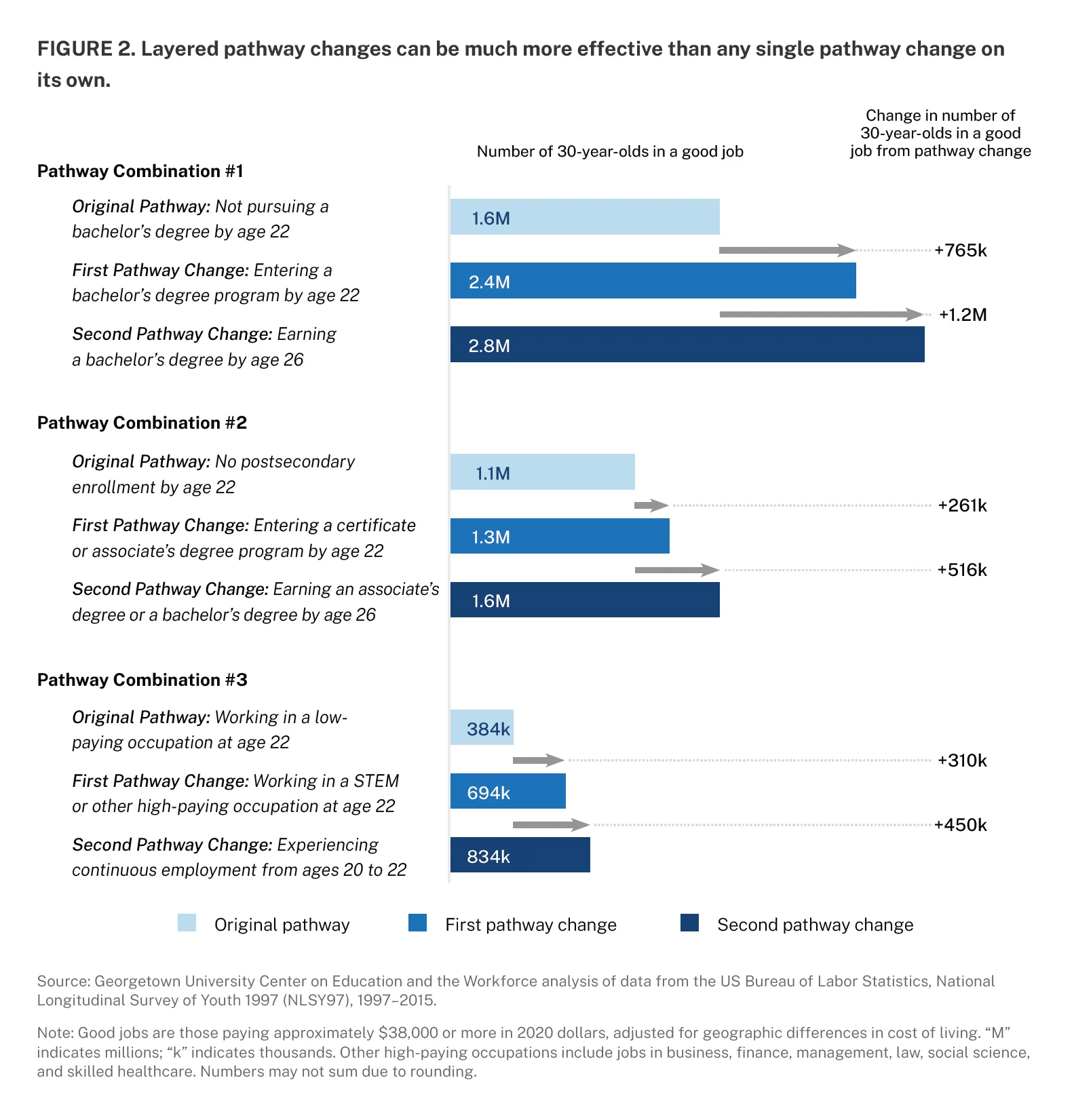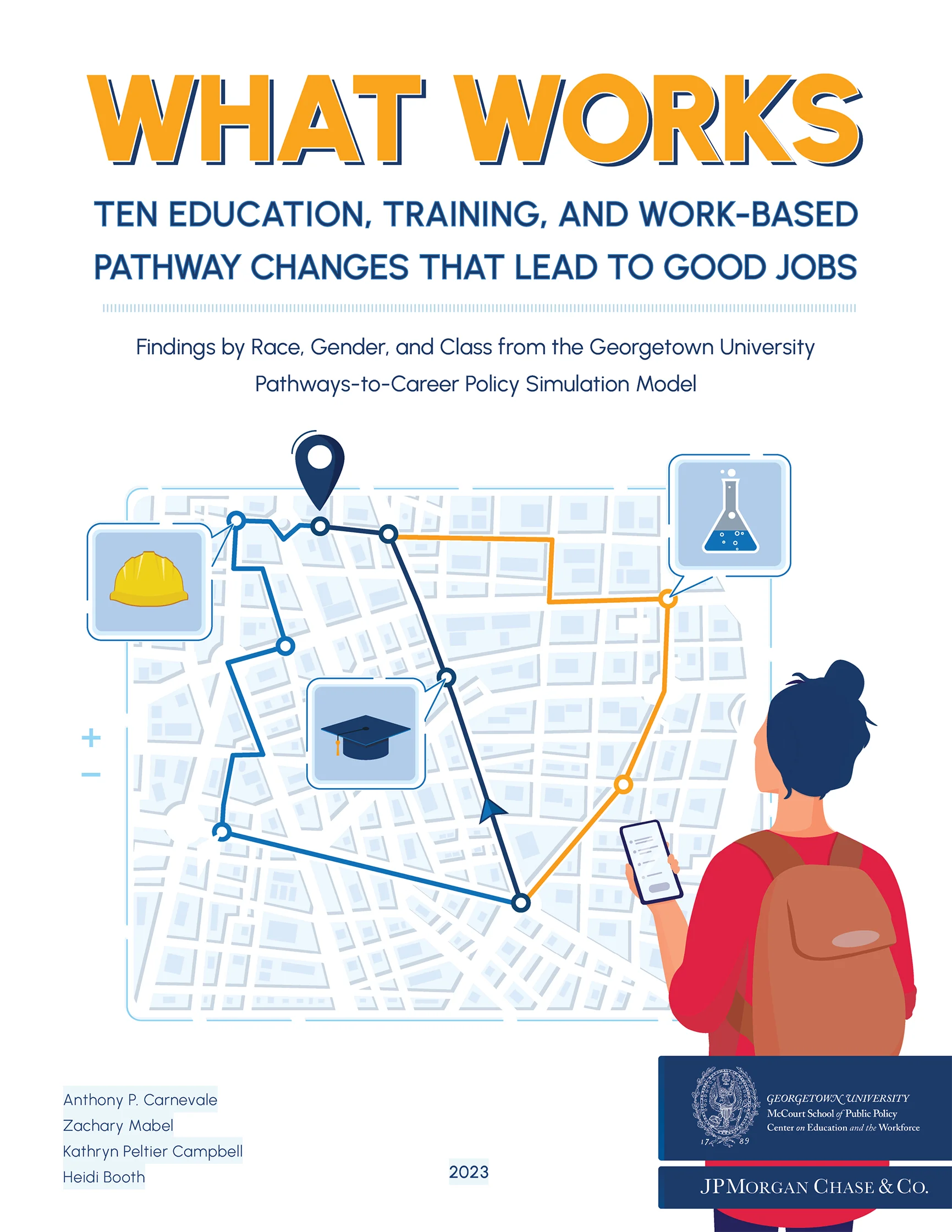Summary
All along the journey from youth to young adulthood, there are critical junctures at which a change in pathway can have a tremendous impact on a young person’s future. What Works: Ten Education, Training, and Work-Based Pathway Changes That Lead to Good Jobs identifies 10 pathway changes with the greatest potential to improve employment outcomes for young adults. The report uses the Pathways-to-Career policy simulation model, developed by CEW researchers using longitudinal data, to identify promising junctures at which strategic interventions could increase the likelihood of working in a good job.
Good Job Definition
We define a good job as one that pays a minimum of approximately $38,000 in 2020 dollars for workers younger than age 45 and a minimum of approximately $49,000 for workers ages 45 and older. For the young adults who are the focus of this report—30-year-old workers nationwide—these jobs pay a median of approximately $57,000 annually. Among 30-year-old workers who have a good job, one-quarter earn less than $46,000 annually, while one-quarter earn more than $76,000. Workers with good jobs are more likely than those with low-paying jobs to have access to healthcare and retirement benefits at work.
Explore the Data
Many of the most promising pathway changes involve increasing educational attainment, especially progressing toward attainment of a bachelor’s degree, while other promising pathway changes replace or combine classroom learning with on-the-job learning. Importantly, the effectiveness of the 10 pathway changes varies by race, gender, and class. For example, specializing in career and technical education (CTE) in high school increases the likelihood of having a good job at age 30 for white and Black/African American young adults, but reduces the likelihood of having a good job at age 30 for Hispanic/Latino young adults. Nearly every pathway change has the potential to put more men, white youth and young adults, and individuals from lower socioeconomic backgrounds in good jobs at age 30.

Explore the number of young people who could benefit from each pathway change, overall and by race, gender, and class:
Source: Georgetown University Center on Education and the Workforce analysis of data from the US Bureau of Labor Statistics, National Longitudinal Survey of Youth 1997 (NLSY97), 1997–2015.
Note: Good jobs are those paying approximately $38,000 or more in 2020 dollars, adjusted for geographic differences in cost of living. “M” indicates millions; “k” indicates thousands. For details about who is eligible for each scenario, see Appendix A in the full report. Blue-collar occupations include jobs in farming, fishing, and forestry; construction, extraction, maintenance, and repair; and production, transportation, and material moving. Other high-paying occupations include jobs in business, finance, management, law, social science, and skilled healthcare. Low-paying occupations include jobs in the arts, community services, education, food and personal services, and healthcare support. Numbers may not sum due to rounding.
Layered Pathway Changes
Layering certain pathway changes can further boost the number of workers in good jobs at age 30. For example, ensuring college completion after putting the 4.8 million eligible academically prepared young adults on the pathway to a bachelor’s degree could result in 1.2 million more young adults in the current cohort in good jobs at age 30 than are expected at present. That’s 435,000 more young adults in good jobs than would result from increasing enrollment in bachelor’s degree programs alone. Ensuring completion of an associate’s or bachelor’s degree after putting young adults on the pathway to an associate’s degree and ensuring continuous employment from ages 20 to 22 after placing young adults in STEM occupations could also enhance the impact of any one of these pathway changes on its own.
Targeted Interventions
Differences in effectiveness and eligibility mean that narrowing the gaps in good jobs is not as simple as making all 10 pathway changes equally available to youth and young adults regardless of race, class, and gender. That approach would more likely increase the good jobs gaps by race and gender than shrink them, and it would have little effect on the good jobs gap by class. To narrow the gaps in the likelihood of having a good job, effective interventions would need to be targeted to underserved groups as part of a coordinated and comprehensive all-one-system approach that addresses persistent inequalities in society arising outside the classroom and workplace.
Resources
What Works: Ten Education, Training, and Work-Based Pathway Changes That Lead to Good Jobs identifies 10 pathway changes with the greatest potential to improve employment outcomes for young adults.


